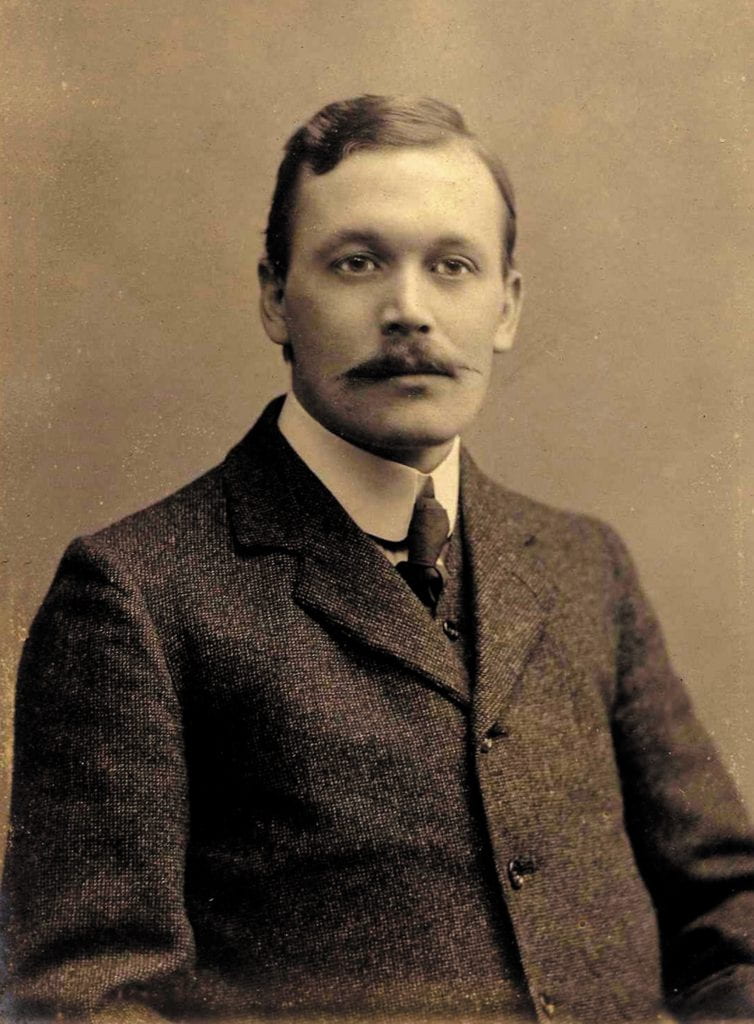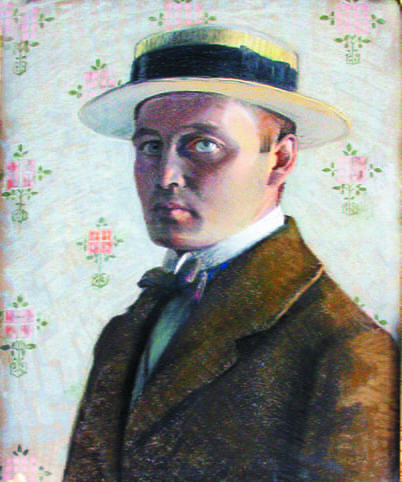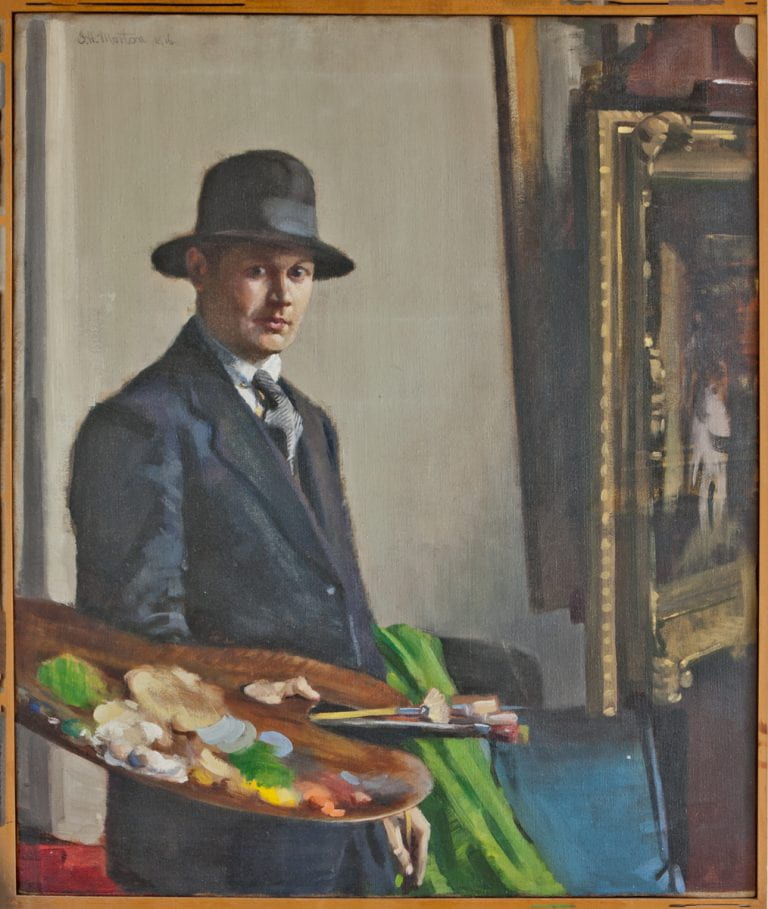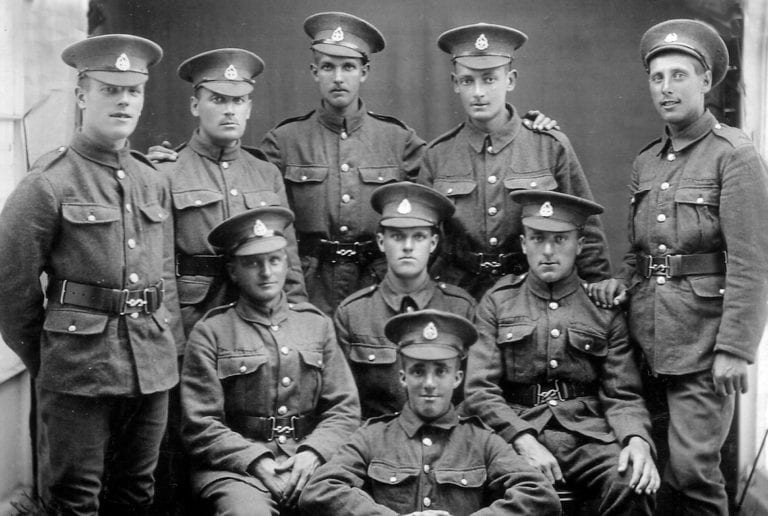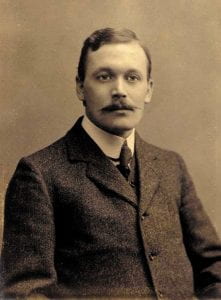
Born: 22 October 1881
Died: 6 November 1918
Studied at RCA: c.1899 – 1904, ARCA Diploma 1904
Unfortunately no student file has been found for James covering his time at the College but, unlike all the others named on the memorial plaque, his upbringing, education, and brief career as ‘the cotton town impressionist’ has resulted in a celebratory biography published in 2013 by the Friends of Darwen Library – Darwen, Lancashire, being James’s home town.
He was the youngest child of five, and the only son, of textile workers, James (senior) and Elizabeth. In 1887 Elizabeth became a widow, bringing up their five children alone. James seems to have been favoured to some extent: during his teens he attended Darwen Technical School and Darwen Higher Grade School, with his exam results in woodwork and ‘Perspective’ appearing in regional newspapers in July (1898) and August (1899). The importance of access to this level of education for working-class children is stressed in an article published by the Northern Daily Telegraph (20 August 1904), which names James as a particular beneficiary of these schools, noting that his attendance had resulted in his being awarded a scholarship and allowance to study at the College for three years (and having this renewed for a further couple of years). The newspaper also announced James had just been awarded his ARCA diploma.
While James certainly seized the opportunity to leave Darwen to further his studies in London, he returned home following a year teaching at Darlington Technical Institution. This may have been initially because his mother was seriously ill, eventually dying in 1906, but his remaining there rather than taking, say, a teaching post elsewhere, also suggests the willingness of his sisters, all unmarried cotton mill warpers, to support him in his endeavours. In the following decade he seems to have been able to devote himself to developing his considerable skills in various media, occasionally exhibiting while also participating in local artistic circles. The sheer quantity of his work from this period, kept by the sisters for the next half-century until Alice, the youngest, died in 1967, seems to show how unlikely it is that he received a reliable income from his art – even though he is recorded in the 1911 Census as working on his ‘own account’ as a ‘Decorative Designer (Wallpaper)’.
A brief glimpse of James – and an indication of the jittery national mood – is found just a month after the declaration of war, when a local newspaper reported that his sketching in the Lake District had aroused the suspicions of a keen constable who needed to be persuaded this was art and not spying. After this, James seems to have continued much as before until 1916 when the introduction of conscription required single men between the ages of 18 and 41 to join up. James appealed for exemption at a military tribunal held in March, on the grounds that he opposed the war and he was an artist who ‘depended upon the skills of his hands’. Unsurprisingly he was not successful. While his service file has not survived, his soldier number indicates he joined the 10th Battalion, East Lancashire Regiment (ELR) in April 1916 with an ‘H’ on at least one record showing this took place at the army’s Preston district office. Once more he left his close-knit family and community, but this time for a very different life.
In the face of so many recruits and training needs, the 10th Battalion was re-designated the 47th Battalion, Training Reserve, 10th Brigade by September, based at Wareham Camp in Dorset. There is no record of how long James remained with the reserve, although it was far longer than usual: a signed and dated sketch James made of Sand Hill Camp, Wiltshire, shows he was still in England during the summer of 1917, while others from the battalion had left for France the year before. While it is possible that he suffered a period of ill-health or lack of fitness that delayed deployment abroad, it is more likely that James had started training other soldiers during this time – after all, he had a teaching qualification, no matter how irrelevant it was to the matter in hand. Later records note his rank as sergeant but, again, provide no date for this promotion.
His record in the Medal Rolls show his subsequent posting to the 3rd Battalion, ELR, and it is possible that he left for France with them at the beginning of 1918, transferring once there to the 2/5th Battalion, ELR: their war diary notes the arrival of several ‘ORs’ (ordinary ranks) from base camp in both January and February as the army tried to make up the losses of the previous year. Unfortunately, this battalion was one of those further devastated by the Spring Offensive in late March. No information related to James during this period has been found. As a non-commissioned officer this would be unlikely at the best of times, let alone this disastrous period. It is apparent, however, that the battalion’s decline continued. Despite more ORs joining them in early April they became part of composite battalion along with another shrunken ELR battalion. In May this was deliberately ‘reduced’ still further to a cadre of ‘10 officers and 45 ORs’ ready to train inexperienced American troops near Abbeville. This seems to have been a brief interlude for James, allowing him time to sketch views around Cayeux-sur-Mer, with a sympathetic commanding officer arranging for the supply of materials. But having completed its task the rump battalion was inevitably disbanded at the end of July with James posted next to the 1/5th Battalion, ELR, a front-line unit with the 126th Brigade, part of the 42nd (East Lancashire) Division. The published biography suggests he served with their A company.
After training in early August, the 1/5ths joined the push back across the Somme region that followed the defeat of German forces at the Battle of Amiens (8 August). Among the many operations taking place, they and presumably, therefore, James, were involved in the capture of Miraumont on the River Ancre, (24 August) and, at the end of the month, the advance on Riencourt to the west of Bapaume. Such now was the energy and strength of the Allied eastward advance that, even with the spread of influenza (which also affected the German army), and despite some strong resistance, the formidable Hindenburg Line began to crumble. But the fighting, and autumnal weather, was unpredictable as the Allies moved towards the River Selle during October, with the 1/5ths taking part in a difficult night attack on the river’s eastern bank that caused many casualties, the now retreating German forces clearly wanting to prevent a rout.
An appendix to the battalion’s war diary covers the action from 3 to 8 November. It describes how difficult and confusing conditions were for the battalions of 126th Brigade (and others) as, already exhausted by the lead up to this particular operation, they entered the vast, boggy Forêt de Mormal, east of Solesmes, to relieve a New Zealand Brigade. Criss-crossed by muddy tracks and badly cratered roads, it was slow going for soldiers and the support they needed. By 4.00pm on the 5 November they had made contact with the brigade officers, but rather than resting up they, and the 1/8th Manchesters, were ordered to move on to the eastern side of the forest, presumably in the hope of benefiting from the cover of darkness. But this did not protect them from intermittent shelling into the trees as they pushed on, reaching the surrounding farmland by 2.00am.
The divisional history, published after the war, recounts that only a few hours later, at 6.30am on 6 November, the advance was resumed ‘with little artillery support’. Although ultimately this was a successful action, it is likely that it was as the battalion proceeded to the road ‘running south from Les 5 Chemins and Hoisies Farm’ that James was caught by machine gun fire from the farm, or the ‘orchards and gardens between Petit Bayay and the River Sambre’. Just five days later the armistice was signed and the war came to an end.
James was buried at the time of his death on the south-eastern corner of an imperfect crossroads made by La Haute Rue, leading away from the forest and a road going north towards Valenciennes. His grave was marked with a cross.
In 1920 he was reburied in Pont-Sur-Sambre Communal Cemetery, France, with his eldest sister, Rachel Ann, providing a single apt description for his gravestone – ‘Artist’.
James was also commemorated on several local memorials, including the Belgrave Independent Meeting House, the Belgrave Young Men’s Class, and the church he attended.
